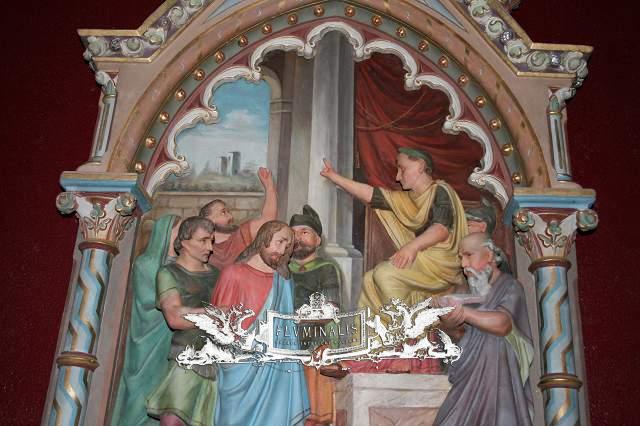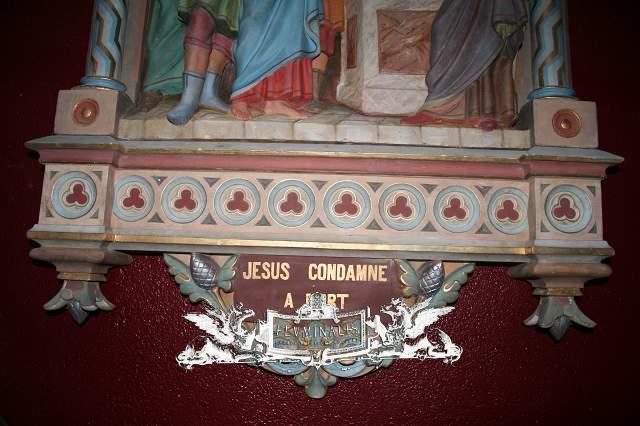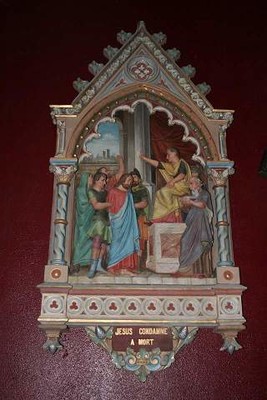Antique Stations of the cross
Antique Stations of the cross (or Way of the Cross; in Latin, Via Crucis; also called the Via Dolorosa or Way of Sorrows, or simply, The Way0 refers to the devotion commemorating the Passion. The tradition as chapel devotion began with St. Francis of Assisi and extended throughout the Roman Catholic Church in the medieval period. It is less often observed in the Anglican and Lutheran churches. It may be done at any time, but is most commonly done during the Season of Lent, especially on Good Friday and on Friday evenings during Lent.
The celebration of the stations of the cross is especially common on the Fridays of Lent, Especially Good Friday. Community celebrations are usually accompanied by various songs and prayers. Particularly common as musical accompaniment is the sequence Stabat Mater Dolorosa. At the end of each station, the Adoramus Te is sometimes sung. The Alleluia is also sung; however, that holy word is buried during Lent.
In all Stations of the Cross the Church shows us Jesus Via Dolorasa. 14 or (new optional) 15 Stations, Jesus going towards Calvary. Fluminalis offers all styles and sizes of the Way to the Cross. As Paintings, in plaster,wood, terra-cotta,woodpap and sandstone with beautiful frames. Measures till 100 inches height. More than 20 classical and authentic complete Via Crucis. Fluminalis is proud to be leader in this industry. In the past there were a couple of private individuals who pioneered the reliqious artifacts industry in the 1970s, but fluminalis has developed this business and continues to remain a leader in our field. We have the largest selection of reliqious artifacts in Europe and operate as a real company providing professional and responsible service to all of those who deal with us. You simply cannot effectively search for a reliqious antique item without first calling Fluminalis. Our inventory,sources,and contacts allow us the greatest opportunity to fill your antique religious needs.
The stations
Traditional form
The stations themselves are usually a series of 14 pictures or sculptures depicting the following scenes:
1. Jesus is condemned to death
2.Jesus receives the cross
3.Jesus falls the first time
4. Jesus meets his Mother
5.Simon of Cyrene carries the cross
6. Veronica wipes Jesus face with her veil
7.Jesus falls the second time
8.Jesus meets the daughters of Jerusalem
9.Jesus falls the third time
10.Jesus is stripped of His garments
11.Crucifixion: Jesus is nailed to the cross
12.Jesus dies on the cross
13.Jesus body is removed from the cross (Deposition or Lamentation)
14.Jesus is laid in the tomb and covered in incense.
Stations of the cross (or Way of the cross; in Latin, Via Crucis; also called the Via Dolorosa or Way of Sorrows, or simply, The Way) refers to the depiction of the final hours (or Passion) of Jesus, and the devotion commemorating the Passion. The tradition as chapel devotion began with St. Francis of Assisi and extended throughout the Roman Catholic Church in the medieval period. It is less often observed in the Anglican and Lutheran churches. It may be done at any time, but is most commonly done during the Season of Lent, especially on Good Friday and on Friday evenings during Lent.
Fluminalis offers you always 30 different sets stations of the cross (14x)
Kruisweg (religie)
De Kruisweg (Via Crucis of Via Dolorosa in het Latijn) is een onderdeel van de totale traditie van het christelijke Paasfeest. Het is een nabootsing van de lijdensweg van Christus vanaf het gerechtsgebouw (het paleis van de Romeinse procurator Pontius Pilatus) tot op de heuvel Golgotha, plaats van zijn terechtstelling.
Het woord statie is afgeleid van het Latijnse woord statio, dat het staan of stilstaan betekent.
In de Rooms-Katholieke traditie is het sinds de 15e eeuw ook een godsdienstoefening, die onder andere op Goede Vrijdag plaatsvindt. Tijdens de Kruisweg gaan de gelovigen biddend en herdenkend langs veertien zogenaamde kruiswegstaties voorbij. Een kruiswegstatie is een schilderij of reliëf dat een scène uit de lijdensweg van Jezus en zijn stervensproces uitbeeldt. De godsdienstoefening wordt door auteurs aan verschillende bronnen toegeschreven. Zo zou de kruiswegoefening teruggaan op de H. Maagd Maria die in Jeruzalem de plaatsen van de Via Dolorosa bezocht. Algemeen wordt echter vooral de werkzaamheid van de H. Franciscus van Assisi verantwoordelijk geacht voor de verspreiding van de gebeden kruisweg.








